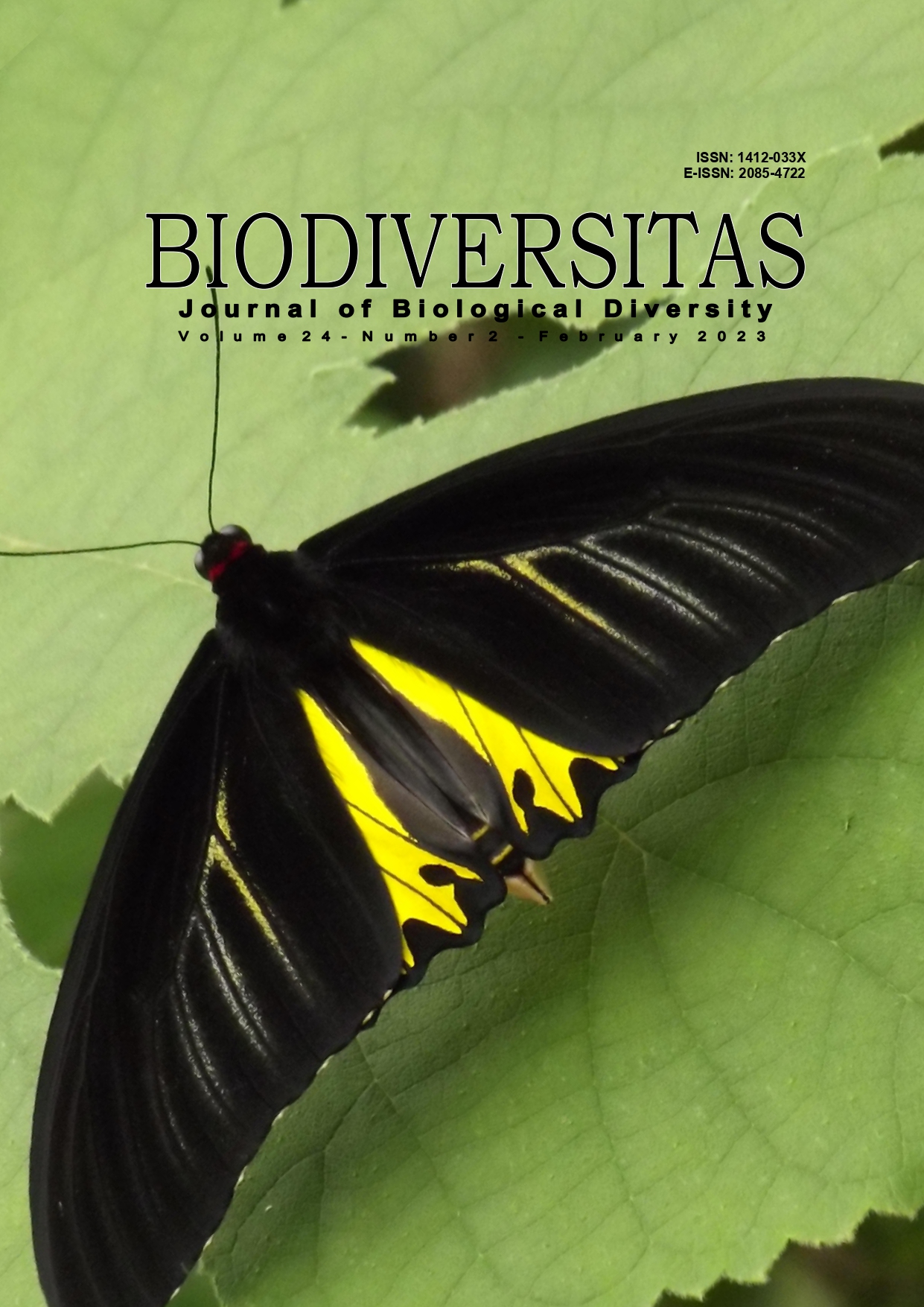Flowering and fruiting phenology of Anaxagorea luzonensis A. Gray (Annonaceae)
##plugins.themes.bootstrap3.article.main##
Abstract
Abstract. Lestari DA, Ningrum LW, Nada FMH, Pradipta NN, Harsono DR. 2023. Flowering and fruiting phenology of Anaxagorea luzonensis A. Gray (Annonaceae). Biodiversitas 24: 784-792. Anaxagorea luzonensis is one of the critical plant collections from the Annonaceae family, with only one specimen in Purwodadi Botanic Garden (PBG). In protecting these plants, it is necessary to know the process of flowering and fruiting through the phenological process. This research is expected to observe plant propagation, physiology, environmental response, and increased reproductive success. The aim of this research is to know the details of flowering and fruiting phenology stages, determine reproductive success, and explain the floral biology of A. luzonensis. Research on the flowering and fruiting phenology of A. luzonensis was carried out from December 2021 – November 2022 in one season at PBG. The method is observative, including changes in color, shape, and size of flowers and fruit in each phenological stage. In addition, the method includes the count of reproductive success and observation of the A. luzonensis flower. This study's results stated that the flowering and fruiting phenology of A. luzonensis experienced a shorter flowering time than fruiting time and a low percentage (<30%) of reproductive success. Flowering stages are divided into five stages, i.e. initiation, flower bud, before bloom, bloom, and anthesis; fruiting stages are divided into three stages, i.e. immature-sized, mature-sized, and ripe fruit, which occurred in period 73-121 ± 85 days. Environmental and genetic factors cause the low value of reproductive success. This research can be useful for the conservation strategy of A. luzonensis, especially for reproduction biology and seed conservation.
##plugins.themes.bootstrap3.article.details##
Most read articles by the same author(s)
- LIA HAPSARI, JEAN KENNEDY, DEWI AYU LESTARI, AHMAD MASRUM, WIWIK LESTARINI, Ethnobotanical survey of bananas (Musaceae) in six districts of East Java, Indonesia , Biodiversitas Journal of Biological Diversity: Vol. 18 No. 1 (2017)
- DESTARIO METUSALA, FAUZIAH, DEWI AYU LESTARI, JANIS DAMAIYANI, SHOFIYATUL MAS’UDAH, HARI SETYAWAN, The identification of plant reliefs in the Lalitavistara story of Borobudur temple, Central Java, Indonesia , Biodiversitas Journal of Biological Diversity: Vol. 21 No. 5 (2020)
- DEWI AYU LESTARI, ABBAN PUTRI FIQA, Environmental factors influence on flowering and fruiting period of selected essential oil plants from Annonaceae , Biodiversitas Journal of Biological Diversity: Vol. 21 No. 3 (2020)
- DEWI AYU LESTARI, RODIYATI AZRIANINGSIH, HENDRIAN HENDRIAN, Taxonomical position of Annonaceae species from East Java, Indonesia: Collections of Purwodadi Botanic Garden based on morphological character , Biodiversitas Journal of Biological Diversity: Vol. 18 No. 3 (2017)
- DEWI AYU LESTARI, WIDJI SANTOSO, Inventory and habitat study of orchids species in Lamedai Nature Reserve, Kolaka, Southeast Sulawesi , Biodiversitas Journal of Biological Diversity: Vol. 12 No. 1 (2011)
- ALIFFIA PRATIWI, DEWI AYU LESTARI, YAYU ROMDHONAH, Short communication: Germination monitoring of selected Annonaceae seeds: Seed bank collections of Purwodadi Botanic Garden, East Java, Indonesia , Biodiversitas Journal of Biological Diversity: Vol. 23 No. 7 (2022)
- DEWI AYU LESTARI, ABBAN PUTRI FIQA, ILHAM KURNIA ABYWIJAYA, Leaf morphological traits of Orophea spp. (Annonaceae): Living collections of Purwodadi Botanic Gardens, East Java, Indonesia , Biodiversitas Journal of Biological Diversity: Vol. 22 No. 6 (2021)
- DEWI AYU LESTARI, RODIYATI AZRIANINGSIH, Short Communication: Species identity and taxonomical position of selected species of Annonaceae based on trnL molecular marker , Biodiversitas Journal of Biological Diversity: Vol. 20 No. 4 (2019)

